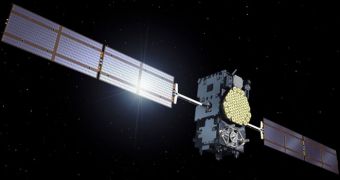The first two spacecraft of the European Space Agency's (ESA) Galileo satellite navigation system have just sent back their first signals from Earth's orbit, marking a tremendously-important milestone for bringing Galileo online.
The In-Orbit Verification (IOV) satellites were only launched on October 21, aboard the first Soyuz rocket to blast off from the ESA Kourou Spaceport, in French Guiana, South America. Since then, experts have been testing and commissioning the spacecraft.
From their orbital perch some 23,222 kilometers (14,430 miles) above the Earth's surface, the two satellites were able to contact the ESA Redu hearing station, which is located in the Ardennes Mountains, at the border between France, Belgium and Luxembourg.
Galileo – an alternative to the American-built GPS – is scheduled to be slowly put together over the next few years. ESA is leading the work, under commission from the European Union.

 14 DAY TRIAL //
14 DAY TRIAL //